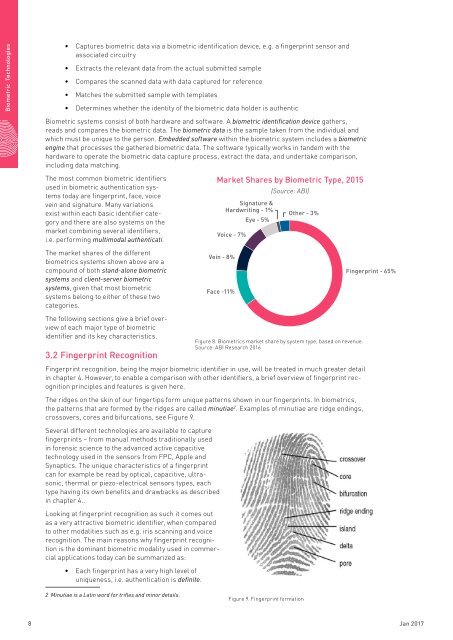BIOMETRIC
Fingerprints-Biometric-Technologies-Whitepaper-January-2017-RevB
Fingerprints-Biometric-Technologies-Whitepaper-January-2017-RevB
You also want an ePaper? Increase the reach of your titles
YUMPU automatically turns print PDFs into web optimized ePapers that Google loves.
J+3+1+5+7+8+11<br />
Biometric Technologies<br />
••<br />
Captures biometric data via a biometric identification device, e.g. a fingerprint sensor and<br />
associated circuitry<br />
••<br />
Extracts the relevant data from the actual submitted sample<br />
••<br />
Compares the scanned data with data captured for reference<br />
••<br />
Matches the submitted sample with templates<br />
••<br />
Determines whether the identity of the biometric data holder is authentic<br />
Biometric systems consist of both hardware and software. A biometric identification device gathers,<br />
reads and compares the biometric data. The biometric data is the sample taken from the individual and<br />
which must be unique to the person. Embedded software within the biometric system includes a biometric<br />
engine that processes the gathered biometric data. The software typically works in tandem with the<br />
hardware to operate the biometric data capture process, extract the data, and undertake comparison,<br />
including data matching.<br />
The most common biometric identifiers<br />
used in biometric authentication systems<br />
today are fingerprint, face, voice<br />
vein and signature. Many variations<br />
exist within each basic identifier category<br />
and there are also systems on the<br />
market combining several identifiers,<br />
i.e. performing multimodal authenticati.<br />
The market shares of the different<br />
biometrics systems shown above are a<br />
compound of both stand-alone biometric<br />
systems and client-server biometric<br />
systems, given that most biometric<br />
systems belong to either of these two<br />
categories.<br />
The following sections give a brief overview<br />
of each major type of biometric<br />
identifier and its key characteristics.<br />
3.2 Fingerprint Recognition<br />
Fingerprint recognition, being the major biometric identifier in use, will be treated in much greater detail<br />
in chapter 4. However, to enable a comparison with other identifiers, a brief overview of fingerprint recognition<br />
principles and features is given here.<br />
The ridges on the skin of our fingertips form unique patterns shown in our fingerprints. In biometrics,<br />
the patterns that are formed by the ridges are called minutiae 2 . Examples of minutiae are ridge endings,<br />
crossovers, cores and bifurcations, see Figure 9.<br />
Several different technologies are available to capture<br />
fingerprints – from manual methods traditionally used<br />
in forensic science to the advanced active capacitive<br />
technology used in the sensors from FPC, Apple and<br />
Synaptics. The unique characteristics of a fingerprint<br />
can for example be read by optical, capacitive, ultrasonic,<br />
thermal or piezo-electrical sensors types, each<br />
type having its own benefits and drawbacks as described<br />
in chapter 4..<br />
Looking at fingerprint recognition as such it comes out<br />
as a very attractive biometric identifier, when compared<br />
to other modalities such as e.g. iris scanning and voice<br />
recognition. The main reasons why fingerprint recognition<br />
is the dominant biometric modality used in commercial<br />
applications today can be summarized as:<br />
••<br />
Each fingerprint has a very high level of<br />
uniqueness, i.e. authentication is definite.<br />
Market Shares by Biometric Type, 2015<br />
65+<br />
Vein - 8%<br />
Face -11%<br />
Signature &<br />
Hardwriting - 1%<br />
Voice - 7%<br />
Eye - 5%<br />
(Source: ABI)<br />
Other - 3%<br />
Figure 8. Biometrics market share by system type, based on revenue.<br />
Source: ABI Research 2016<br />
Fingerprint - 65%<br />
2 Minutiae is a Latin word for trifles and minor details.<br />
Figure 9. Fingerprint formation<br />
8 Jan 2017


